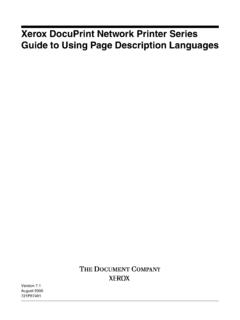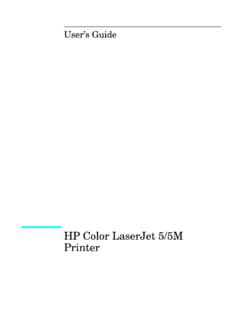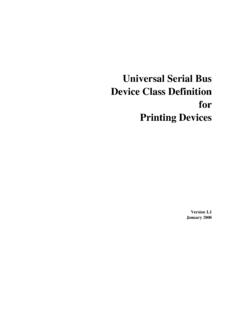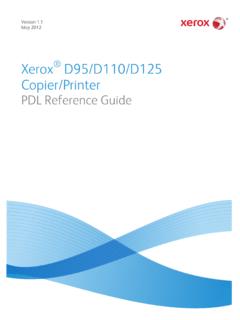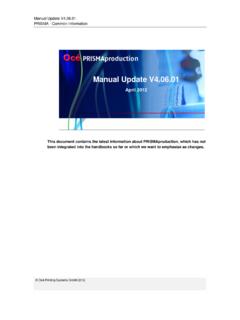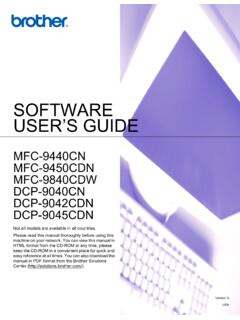Transcription of Printer Job Language Technical Reference Manual - LPRng
1 Printer Job LanguageTechnical Reference ManualEdition 10E1097HP Part No. 5021-0380 Printed in 10/97 NoticeThe information contained in this document is subject to change without MAKES NO WARRANTY OF ANY KIND WITH REGARD TOTHIS MATERIAL, INCLUDING, BUT NOT LIMITED TO, THE IMPLIED WARRANTIESOF MERCHANTABILITY AND FITNESS FOR A PARTICULAR PURPOSE. Hewlett-Packard shall not be liable for errors contained herein or for incidental consequential dam-ages in connection with the furnishing, performance, or use of this document contains proprietary information which is protected by copyright. All rightsare reserved. No part of this document may be photocopied, reproduced, or translated with-out the prior written consent of Hewlett-Packard Company.
2 Copyright 1997 by HEWLETT-PACKARD , PostScript, and the PostScript logo are trademarks of Adobe Systems Incorporated,which may be registered in certain jurisdictions. AppleTalk is a registered trademark of Apple Computer, Inc. Centronics is a registered trademark of Centronics Data Com-puter Corporation. Bi-Tronics and HP Explorer Software are trademarks and PCL andResolution Enhancement are registered trademarks of Hewlett-Packard Company. Epson is a registered trademark of Epson America, Inc. Harvard Graphics is a registered trade-mark of Software Publishing Corporation. IBM is a registered trademark and ProPrinter isa trademark of International Business Machines Corporation.
3 Lotus and 1-2-3 are regis-tered trademarks of Lotus Development Corporation. Microsoft is a registered trademarkand Word, Windows, MS-Mincho, and MS-Gothic are trademarks of Microsoft is a trademark of Seiko-Epson Corporation. WordPerfect is a registered trademarkof WordPerfect Corporation. First Edition September 1992 (P/N 5961-0512) Second Edition May 1993 (P/N 5961-0998)Third Edition July 1993 (P/N 5961-0603)Fourth Edition May 1994 (P/N 5961-0636)Fifth Edition September 1994 (P/N 5961-0704)Sixth Edition May 1995 (P/N 5010-3996)Seventh Edition October 1995 (P/N 5010-3999)Eighth Edition May 1996 (P/N 5961-0938)Ninth Edition October 1996 (P/N 5021-0328)Tenth Edition October 1997 (P/N 5021-0380)ii Inside This ManualWhat You Can LearnFrom This ManualPrinter Job Language (PJL)
4 Was developed byHewlett-Packard to provide a method for switching printerlanguages at the job level, and for status readback betweenthe Printer and the host computer. PJL offers applicationprograms an efficient way to remotely controlHewlett-Packard printers. Using PJL, developers canprovide applications with the ability to programmaticallyswitch Printer languages, monitor Printer status, requestthe Printer model and configuration, change control paneldefault settings, modify control panel messages, and Manual is written for experienced users such asapplication developers and Technical support using PJL commands, programmers should befamiliar with the introductory information in Chapters 1, 2,and 3, and with the programming tips in Chapter 10.
5 Inaddition, users of this Manual should be acquainted withthe HP LaserJet Printer Language (PCL) and with LaserJetprinter PJL Technical Reference Manual provides developerswith all the information necessary to add PJL to theirapplications. Examples are used throughout the Manual tohelp developers write efficient and properly functioning SupportPersonnelThis Manual provides Reference information for networkadministrators and other Technical support personnel whomanage multi-user systems. PJL provides the potential forsignificantly enhancing network Printer UsersNon- Technical users can use the features of PJL by usingHP Explorer Software, or by using software that supportsPJL.
6 Since improperly used PJL commands can causeproblems in a network situation, inexperienced users areadvised against using PJL commands on any system otherthan a dedicated Manual is comprised of ten chapters and fourappendices. The first three chapters introduce you to therange of PJL features, PJL syntax and format, some rulesabout using PJL, and a brief description of each 4 explores the essential kernel commands thosecommands that are part of almost every PJL job. Chapters5 through 9 each describe a separate group of relatedcommands. The remaining chapters cover programmingtips and related PJL information. A brief description of eachchapter is provided 1.
7 Introduction to PJLThis chapter explains what PJL is, who should use PJL,and the benefits of using PJL in application programs. Italso covers compatibility with non-PJL printers, whichincludes HP LaserJet printers, HP DeskJet printers, andHP DesignJet plotters and 2. PJL Command Syntax and Format Chapter 2 explains the conventions used to describe PJLcommand syntax. The chapter also explains the formatsthat PJL commands follow and describes what happenswhen the Printer receives an illegal 3. Using PJL This chapter explains how PJL commands are used,including the requirements of a PJL job and examplesshowing basic PJL command structure.
8 In addition, thechapter categorizes the PJL commands in this Manual bytheir functionality, along with a brief command 4. Kernel CommandsThis chapter explains the three core commands used inmost PJL jobs: the Universal Exit Language (UEL)command, the COMMENT command, and the ENTER command. The chapter also describes the related topics ofimplicit and explicit Printer Language 5. Job Separation CommandsChapter 5 describes the JOB and EOJ commands, whichare used in combination to define job boundaries andprovide job-related feedback, such as job 6. Environment CommandsThis chapter explains setting the Printer to a known DEFAULT, INITIALIZE, RESET, and SET commandsare explained 7.
9 Status Readback CommandsChapter 7 describes status readback, the format of statusreadback responses, using software tools to interpret statusreadback, and the commands associated with statusreadback (INQUIRE, DINQUIRE, ECHO, INFO,USTATUS, and USTATUSOFF). This chapter also coversthe processes involved in job recovery and monitoring theprinter control 8. Device Attendance CommandsChapter 8 describes the commands used to displaymessages on the Printer control panel: the RDYMSG,OPMSG, and STMSG 9. PJL File System CommandsChapter 9 describes the commands used for managing aprinter-based disk drive, or other Printer -based massstorage.
10 The commands include FSAPPEND, FSDIRLIST,FSINIT, FSMKDIR, FSQUERY, FSUPLOAD, FSDOWN-LOAD, and FSDELETE. These commands provide thecapability to initialize the mass storage, make directories,list directories, and download, upload, delete, and append 10. Programming TipsThis chapter demonstrates how to create well-formed jobsand discusses common problems and things to watch forvwhen using PJL commands. Samples are included todemonstrate different types of applications. Appendix A. Product-Specific Feature SupportThis chapter lists all of the PJL commands and showswhich commands are supported by the different PJLprinters.

